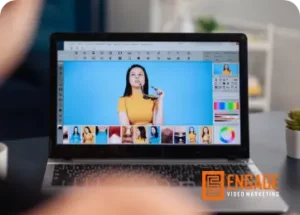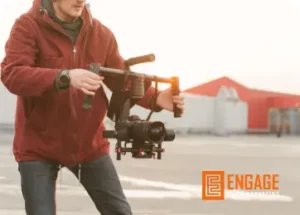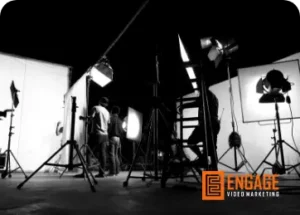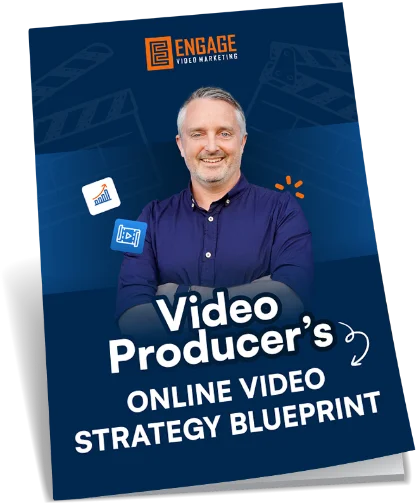When you’re planning out a video strategy for your business, it’s easy to get overwhelmed and either not take action as a result or take the wrong action, which fails to get results. So in this article, I’m going to share with you 7 simple questions that you can ask yourself so that you can be more strategic with the videos that you’re creating for your business. And the critical paradigm shift, I guess, here is that production or how you actually produce the video is actually the last question that you need to ask yourself. And that’s where so many people get bogged down. So let’s dive into my 7 questions for an effective video strategy for your business.
Q1: Who is the intended audience for this video?
Every video that’s created for a business or any video is created for someone. It’s intended to reach a particular audience, even though it’s your business creating it, you’re creating it for someone. So you really need to know who that someone is. It’s a good idea to think of the person that you’re creating this video for as an ideal customer for your business, and either create an imaginary real person that you’re creating this video for who is your ideal customer, or actually think in your mind of someone who has been your ideal customer in the past and create this video for them. Critically, you need to understand why they would want to watch this video, not why you want to create this video for them, but why they would want to watch this video. So that’s the first question to ask yourself.
Q2: What is the business goal for this video?
Any video that’s created for a business needs to be aligned to some kind of an outcome that’s going to make sense for your business to move the needle in some way. So here, you want to be getting clear on what do you want that ideal audience to think, feel or do after they’ve watched this video – that becomes the goal for the video. Is this video intended to raise awareness of your brand, build credibility of you as an expert, encourage trust with your ideal customer, or encourage your click-through to a website to take some sort of action there, or even to make a sale? When you get clear on the goal for your video, you can be much more strategic about how you create that video and the rest of the video strategy we’re going to break down in the following questions.
Q3: What is the content that is going to be shared in this video?

For any video, you need to really understand the value that’s going to be shared, or the idea that’s going to be exchanged within the content of your video. You want to be providing value to your audience – entertaining, informing, educating, inspiring. There needs to be a reason why someone is going to watch this video, and you need to be clearly understanding the value that you’re going to impart through the video that you’re sharing. Remember that it’s not about you, it’s about the value that you’re going to be sharing with that ideal audience member of that video. How’s it going to make their life better by spending a few minutes watching your video?
Q4: Where are you going to distribute this content?
You see when you’re thinking strategically about creating a video, it’s important before you ever create the video to understand the platform that you’re going to distribute this video on. And I recommend that you decide on a primary distribution platform first. So is this video created for YouTube primarily? Is it created for Facebook, LinkedIn, Twitter, Instagram, IGTV?
When you get clear on the primary distribution platform for your video, you can be much more strategic about how you actually create the content. The platform is going to inform the style of the content, the style of delivery in the video, whether it’s informal or more professional, more relaxed or more creative and storytelling driven. All of these decisions about how you produce the video are actually going to be informed by the distribution channel that this video is intended for. Don’t forget here to consider possible re-purposing options for your video as well. So you can create a video that’s designed for a primary distribution channel, but then think creatively about how you can repurpose that video for other distribution channels as well. Maybe it’s making slight variations or shorter cut down versions of the video. All of this is part of the decision making you need to make before you create the video when you’re being strategic about your video marketing.
Q5: How are you going to optimise this video in order for it to be seen by the right people?
When we talk about video optimisation, I don’t want you to get bogged down in technical stuff here, but there’s really two things at play.
- Number 1 is the algorithm that controls whether or not your video actually gets shown to the people that you’re intending to see it.
- Number 2 is the audience itself, which is recognising that even if your ideal audience sees your video, they may not click play on your video.
And even if they click play on your video, they may not actually watch enough of your video to get the transfer of information you want to pass-on on this video. So when you’re optimising your videos, you need to look at how you can do things to your videos on the platforms that you’re going to be distributing them on, in order to maximise the exposure and impact of your videos on those platforms.
Some of the key ways to think about this for algorithm optimisation is thinking about how people are going to search and find your videos in the first place. So maybe you do some keyword research. Maybe you spend some time thinking about the distribution platform you’re sharing this video on, and think about how are people using that platform and how is your video going to show up on that platform so that it makes sense for the viewer.
When it comes to audience optimisation, I want you to think most importantly about how you’re going to hook the viewer in, in those opening seconds. So what are you going to do in your video to get them to pay attention right from the opening seconds, and then to watch the video for a suitable duration in order to impart the information that you want to share. So this comes down to structuring your videos or the energy in your videos, or the way that you edit your videos, making decisions about all of these things is part of a critical strategic decision making process before you press record on the camera.
Q6: How are you going to measure the results to determine whether or not your video’s even successful?
What we’re talking about here is really understanding the metrics that matter for your particular video. When you’re deciding on the metrics to pay attention to, don’t just think about the obvious ones like views, how many views did your video get, but think instead about maybe its retention rate. So how long someone watched your video for, or maybe it’s more important to you to measure the click through to your website, or measure the sales conversion rate so how it impacted on people actually adding products to a cart, for example. Spend some time here to determine what metrics are you going to pay attention to, to determine whether the video has been successful in achieving the outcome that you wanted the video to achieve.
Q7: How will you actually produce the video?
What is the method and style of production for your video? And it’s important that you consider this last, because the answers that you came up with to the previous 6 questions that we’ve been through is going to inform how you actually should be approaching the production of the video. So whether it’s a DIY type video, whether you shoot it on your iPhone as you’re walking down the street, or whether you hire a production company and invest bigger budget into this video, whether it’s a live video or whether it’s a prerecorded video, can it be done as a longer form webinar, or should it be a 30-second infographic or animation? All of these production decisions should be made as a result of the answers you’ve already made to the previous 6 questions.
By considering answers to each of these 7 questions, you’re going to be way more strategic with your video marketing than 99% of other videos produced by businesses. And therefore your video is more likely to be set up to return on that video investment and actually get results for your business, which after all is exactly why you’re doing it in the first place.




